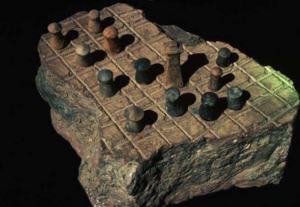Talk:Indoor Sports:Chess
By Vishal Agarwal and The Hindu Society of Minnesota
Chess was called Śatarañj in India. This word, which is still used in modern Indian languages, is a corruption of the Sanskrit word Caturaṅga. This is so as the game of Caturaṅga was in ancient times played on a piece of cloth, in place of the modern chess board. In literature, its first mention is in Bāṇa Bhaṭṭa’s Kadambarī (7th century CE). The game, however, seems to be very ancient because a specimen of a chess board with squares and carved pieces resembling modern chess pieces has been unearthed from a town called Lothal in Gujarat in west India. Scientists have dated them to 2200 BCE.
'Story: Invention of Chess by Śeṣa'
A wise man named Śeṣa is credited with the invention of Caturaṅga, the older form of chess, in India. When he first demonstrated the moves of the game to his king, the latter was very impressed and said, “This is a brilliant game. Ask me for a reward.” But Śeṣa felt that the king was impatient and inattentive and was merely trying to flaunt his generosity instead of truly understanding the game. Therefore, he replied, “Your Majesty! I want one grain of wheat for the first square on the board, 2 for the second, 4 for the third, 8 for the fourth and so on.” The king became impatient and replied, “Ok, ok, my mathematicians will calculate the number of grains and deliver the sack to your home yesterday.”
Surprisingly, the next day, the royal mathematician appeared in the court and said, “Your Highness, even all the grain produced in your kingdom will not meet Śeṣa’s demand.” Śeṣa's clever request was based on exponential growth.
He asked for:
- 1 grain of wheat on the first square,
- 2 on the second,
- 4 on the third,
- 8 on the fourth, and so on...
This doubling continued across all 64 squares of the chessboard. The total number of grains requested follows a geometric series:
- 1 + 2 + 4 + 8 + ... + 2^{63} = 2^{64} - 1 = 18,446,744,073,709,551,615 grains
To understand how massive this is:
- If 1 grain weighs approximately 0.065 grams, then the total weight would be over 1.2 trillion metric tons.
- The entire world produces only about 800 million metric tons of wheat per year.
Even collecting all the grain in the king’s kingdom (or the whole world!) wouldn't fulfill this demand.
Historical Spread of Chess from India
The Encyclopedia Britannica concludes that "Other Persian and Arabian writers state that Shatranj came into Persia from India and there appears to be a consensus of opinion that may be considered to settle the question. Thus we have the game passing from the Hindus to the Persians and then to the Arabians, after the capture V of Persia by the Caliphs in the 7th century, and from them, directly or indirectly, to various parts of Europe, at a time which cannot be definitely fixed, but either in or before the 10th century. That the source of the European game is Arabic is clear enough, nor merely from the words "check" and "mate", which are evidently from Shah mat ("the king is dead"), but also from the names of some of the pieces."
Thus, it was from India that the ancient Persians are said to have learnt this game, and from them it was transmitted to the Greco-Roman world. The evidence of the Persians having borrowed this game from India is seen in the name the Persians gave to it. The Persian word for chess is Catrang, which was later changed by the Arabs to Śatarañj. As said in Encyclopedia Britannica, this word is obviously a corruption of the Sanskrit original Caturaṅga.


